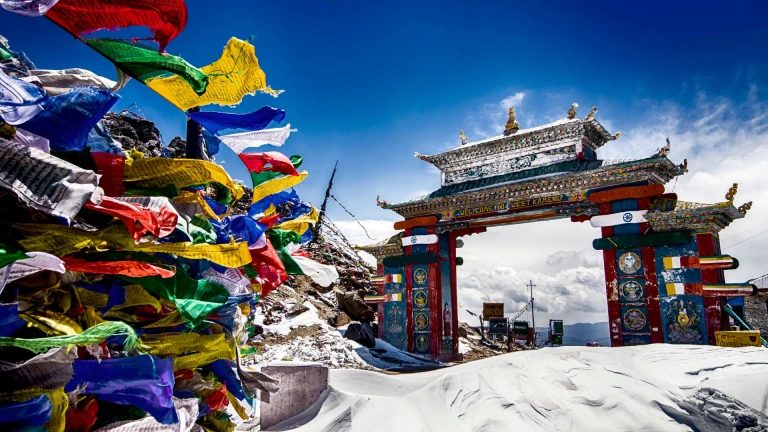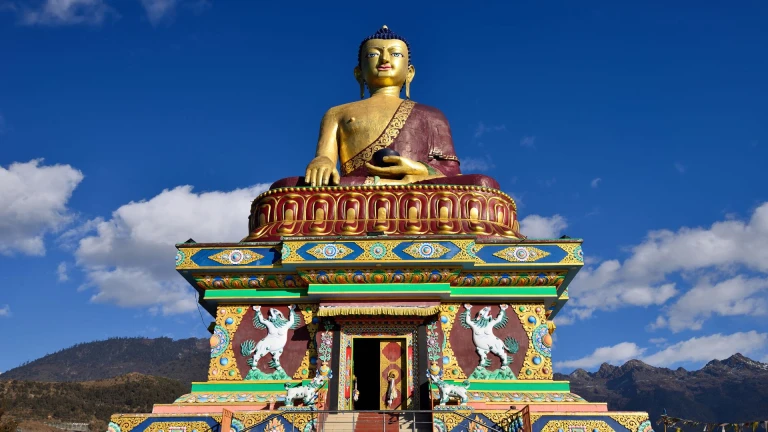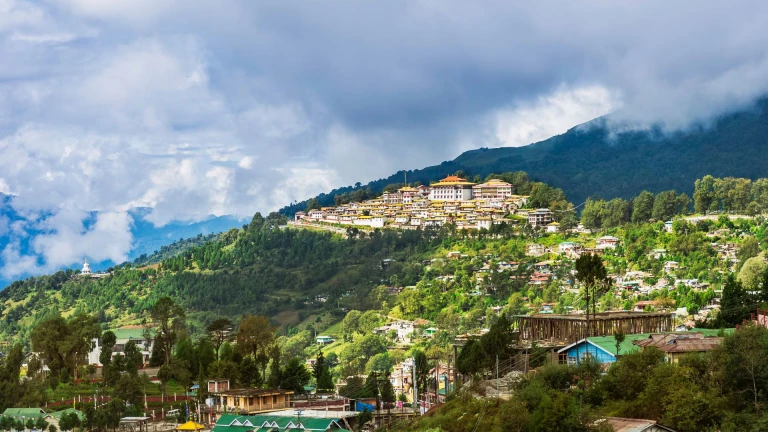Discover India's Largest Monastery, the Second Oldest in Asia
Tucked away in the eastern Himalayas of India, in the state of Arunachal Pradesh, lies a mystical and serene haven of Buddhist spirituality known as the Tawang Buddhist Monastery.
This religious and cultural site is not only a symbol of faith but also proof of the rich heritage of Tibetan Buddhism in the region.

History and Origins
The Tawang Monastery, also referred to as Galden Namgyal Lhatse has a history that spans over 400 years.
It was founded by Merak Lama Lodre Gyatso in the 17th century, by the wishes of the 5th Dalai Lama, Ngawang Lobsang Gyatso.
The name "Tawang" is believed to be derived from "Ta" meaning horse and "Wang" meaning chosen, signifying the divine horse which is said to have discovered the location of the monastery.
The monastery is a part of the Gelugpa (Yellow Hat) sect of Tibetan Buddhism, which was also founded by the great Tibetan saint and philosopher Je Tsongkhapa.
Tawang Monastery has since become one of the most important centres of Tibetan Buddhism outside Tibet.
Architectural Marvel

Tawang Monastery is renowned for its breathtaking architecture that blends seamlessly with the natural surroundings.
The monastery is perched at an altitude of 10,000 feet, offering panoramic views of the Tawang Valley.
The complex is an intricate mix of white and golden-yellow structures, adorned with colourful frescoes, murals, and intricate carvings.
The main assembly hall, known as the Dukhang, is the heart of the monastery and stands as a testament to Tibetan craftsmanship.
It houses a three-story high statue of Lord Buddha, made entirely of gold. The library, the Dung Gyur Mani, contains an extensive collection of rare and ancient Buddhist scriptures and texts, some of which are more than 400 years old.
Cultural Significance
Tawang Monastery plays a central role in preserving and propagating Tibetan Buddhism and culture in India.
The monastery serves as a hub for religious and spiritual activities, drawing pilgrims and tourists alike.
The annual Torgya Festival is a significant event where monks perform traditional Cham dances, believed to ward off evil spirits and bring blessings to the community.
Monks residing in Tawang Monastery dedicate their lives to meditation, learning, and service to the community.
They follow a rigorous routine that includes prayer sessions, rituals, and philosophical studies.
This dedication to spiritual growth and service is a hallmark of Tibetan Buddhist monastic life.
Also Read: Incredible India’s UNESCO Gems: A Traveler’s Delight
Social and Educational Contributions
Beyond its religious significance, Tawang Monastery has contributed significantly to the social and educational development of the region.
The monastery runs schools that provide education to children from remote areas, helping to uplift the community.
Additionally, it provides healthcare services to the locals through its medical facilities.
Tourism and Visitor Experience

Tawang Monastery attracts a steady stream of tourists from around the world.
Visitors are not only awed by its spiritual aura but also by the natural beauty of the Tawang Valley.
The monastery provides an opportunity for travellers to learn about Tibetan Buddhism, witness traditional ceremonies, and soak in the tranquillity of the surroundings.
Visitors are encouraged to be respectful of the monastery's rules, which include appropriate dress and behaviour within the sacred precincts.
It's customary to walk clockwise around the main prayer hall, turning prayer wheels and spinning prayer flags to invoke blessings.
Permit Requirement
Indian tourists are required to obtain an Inner Line Permit (ILP) to visit the Tawang Monastery. These permits can be obtained from the Arunachal Pradesh tourism office in Guwahati or on the Department of Tourism website.
How to Reach the Monastery
Tawang Monastery's remote location adds to its mystique but also requires some effort to reach.
By Air
The nearest airport to Tawang is Salonibari Airport in Tezpur, Assam, which is approximately 380 kilometres away from the monastery.
You can book a flight to Salonibari Airport from major Indian cities like Kolkata and Guwahati. From the airport, you can hire a taxi or take a bus to Tawang.
Keep in mind that flights to Salonibari Airport may be subject to weather conditions, so it's advisable to check the schedule in advance.
By Road
Tawang is well-connected by road, although the journey can be long and winding due to the mountainous terrain. The most common route is from Guwahati, Assam, which is about 450 kilometres away.
You can either hire a taxi or take a bus from Guwahati to Tawang.
The journey offers breathtaking views of lush forests, rivers, and snow-capped peaks.
It's essential to plan your trip well and consider road conditions, as some stretches may be challenging, especially during the winter months.
By Train
The nearest railway station to Tawang is in Tezpur, Assam.
From Tezpur, you can continue your journey by road, either by taxi or bus.
The Tezpur railway station is well-connected to major Indian cities.
Best Time to Visit
The best time to visit Tawang Monastery and the surrounding region is during the late spring, summer, and early autumn months, which span from April to October. Here's a breakdown of the seasons:
Spring (April to June)
The weather is pleasant, with temperatures ranging from 5°C to 20°C (41°F to 68°F).
The lush green landscapes, blooming rhododendrons, and clear skies create a picturesque setting for exploring the monastery and the beautiful Tawang Valley.
Summer (June to September)
Summer is a great time for trekking and exploring the natural beauty of the region.
While temperatures during the day can range from 10°C to 22°C (50°F to 72°F), evenings can get cooler.
However, this season also brings occasional rainfall, so it's essential to be prepared for wet weather.
Autumn (October)
Early October marks the beginning of autumn in Tawang.
The weather remains pleasant, with daytime temperatures ranging from 5°C to 15°C (41°F to 59°F).
The clear skies and colourful foliage make this a great time for both religious and outdoor activities.
It's advisable to avoid visiting during the winter months (November to March) as the region experiences heavy snowfall, extremely cold temperatures, and the risk of road closures due to snow and ice.
Planning your trip during the recommended months ensures a more comfortable and enjoyable experience at Tawang Monastery and its surroundings.
Also Read: Exploring India's 2023 Cricket World Cup Venues: A Culinary and Cultural Journey
The Tawang Buddhist Monastery stands as a testament to the enduring spiritual legacy of Tibetan Buddhism in the Indian Himalayas. Its rich history, stunning architecture, cultural significance, and contributions to the community make it a unique and invaluable treasure. Beyond its religious importance, Tawang Monastery offers visitors a glimpse into the profound world of Buddhism and a chance to connect with the spiritual and natural beauty of the region. It is indeed a sanctuary of serenity, a place where the soul can find peace amidst the majestic Himalayan peaks.
Published at
About Author
Yashas
Subscribe our Newsletter
Get our weekly tips and travel news!
Related Posts
10 Amazing Backpacking Destinations to Add to Your List in 2024
From spiritual havens to nomadic adventures, explore a tapestry of cultures and landscapes, promising an unforgettable journey.
10 Amazing New Attractions in Singapore - Indian Travelers Guide 2025
Explore the new yet amazing attractions of Singapore
10 Amazing Reasons to visit Tanzania, East Africa
Explore Tanzania's allure—an enchanting blend of diverse cultures and stunning landscapes, resonating with the spirit of India. Here are 10 reasons to make it your next adventure!
10 Amazing Things to Do in Azerbaijan That Indians Often Miss
Azerbaijan offers a blend of ancient history, modern architecture, and breathtaking landscapes that Indian tourists often miss. From the mesmerizing Caspian sea to the serene village of Lahij, here are 10 must-do experiences tailored for Indian tourists.
10 Amazing things to do in Budapest, Hungary
Dive into the "Pearl of the Danube" with our top 10 picks for an unforgettable Budapest adventure! From steaming in Szechenyi Baths to conquering Buda Castle, get ready for historic gems, vibrant ruin bars, and langos.
Latest Posts
You don't Need FASTag anymore? Everything you need to know!
No more FASTag from May 1st?
10 Dreamy Experiences for Couples in Kashmir
Fancy some romantic experiences in Kashmir?
How much will a trip to Indonesia cost from India? Travel Budget Guide
Need to budget a tropical getaway from India to Indonesia?
Indian Traveler's 7 Day Itinerary for Island Hopping in Indonesia
Your perfect Indonesian island getaway guide is here!
Best 4-Day Itinerary for Kashmir, India
Ready to fall in love with Kashmir in just four days?

